The recently launched Vivo V40 5G is a highly camera-centric phone, and this time, Vivo has collaborated with Zeiss for the camera features, along with several other interesting specifications. Based on my user experience over the past week, I will share in today’s review what are the pros and cons of this phone. Let’s start with its design and build quality, which is a highlight of this device. The phone is very sleek, and once you hold it, you will definitely feel a premium quality, with a thickness of just 76 mm.
Although this phone is equipped with a 5500 mAh battery, which was quite surprising to me, it weighs only 190 grams. So, even while using it one-handed, I didn’t feel uncomfortable at all. The body is curved, which adds to the slim feel of the display. The back of the phone is glass, as is the front, and this glass has been treated with a protection called “Short Sensation Alpha.” This protection is not as well-known as Gorilla Glass, but it is a similar type of protection used here.
The back glass has a frosted type finish with a matte feel, providing a very nice tactile experience. This phone is available in two colors: purple and white. The camera housing has also been designed uniquely. At the bottom, there’s an LED flash, called the Aura Light, along with two sensors that have Zeiss branding next to them.
We will definitely discuss the camera in detail later. Due to the slim design of the phone, they couldn’t include a 3.5 mm audio jack. However, it does have a USB-C port, bottom-facing speaker, primary microphone, and a SIM card tray. There is no option for expandable storage. At the top, it states “Professional Portrait,” and there’s a secondary noise cancellation microphone. By the way, this phone has stereo speakers, and the sound quality produced is decent. It’s not very loud, but the sound quality is satisfactory.
Another good feature is that this phone has an IP68 and IP69 rating, making it waterproof. You can keep it underwater for up to 30 minutes, at a depth of 15 meters, without any issues. So, if you are looking for a waterproof phone, this is definitely a good choice. Overall, I found the build quality and design to be absolutely perfect.
Now, let’s move on to the display. This phone features a 6.78-inch AMOLED panel with a 120 Hz refresh rate, and the display resolution is 1260 by 2800. The camera cutout in the center is very small, providing an immersive experience from the display. The slight curvature on the sides makes it visually appealing. However, the curvature is not so much that if you hold the phone firmly, you’ll experience mis-touches or other problems while using it. I haven’t faced any such issues so far, so the curvature is fine.
Additionally, the display protection is installed by default, so I don’t anticipate any issues. Therefore, the content-watching experience on this display is excellent. Color reproduction is accurate, and you can change the color profile from the settings. The touch response was very good, and there were no issues with viewing angles or color negativity that typically occur with such phones. However, one very interesting specification of this display is the 4500 nits local peak brightness.
The term “local” here is very important because some people might get confused when they hear about 4500 nits. They might think, “Wow, we don’t even see that brightness in flagship phones!” In flagship phones, we typically see a maximum of around 2600 nits, and some may reach 1700 nits. But 4500 nits sounds like it would be blindingly bright. However, it’s not quite as extreme as it sounds because there is a diminishing return when brightness exceeds 2000 nits.
When brightness goes above 2000 nits, it doesn’t get significantly brighter. No matter how high you go, the brightness only increases slightly. But here, the term “local” that I mentioned before is crucial. There are techniques for measuring brightness that have some loopholes. Vivo is not misleading you, but when they measured this brightness, they did so under low Average Picture Level (APL) conditions.
When measuring the brightness of a certain area on an AMOLED display, we know that the pixels light up individually. So, when brightness is measured in HDR situations where less than 5% of the area is lit, the reading becomes very high. They used this same method here, which allowed them to claim 4500 nits. But in real life, if you measure at 100% APL, the brightness would not be as high. That doesn’t mean the display isn’t bright; it’s adequately bright. Indoors, you won’t face any issues, and even outdoors, we didn’t have any visibility problems in direct sunlight.
So, in practical use, there are no issues with brightness. But don’t get too excited or anxious when you hear 4500 nits; it’s not as extreme as it seems. Just clarifying that point.
Before proceeding further, let me mention the price of this phone. It has been officially launched at ₹32,420 and is available in the 12/256 GB variant.
Now, since this phone is camera-centric, I would like to talk a bit about the camera. First, let me clarify the collaboration with Zeiss. For those who are unaware, Zeiss is a very renowned company. From the lenses used to photograph the moon to the lenses used in major Hollywood productions, Zeiss lenses are ubiquitous.
The professionals who worked on this phone in collaboration with Zeiss are truly skilled, and the camera includes a 50 MP main camera, a 12 MP ultra-wide lens, and a 2 MP macro lens. There is a 32 MP selfie camera on the front.
Now, let’s take a look at some pictures. Another interesting feature of this camera is that it comes with a separate gallery shot. Users have been provided with a lot of convenience. However, the camera profiles have been differentiated. Since we’re discussing the camera in detail, let’s move to the next chapter.



